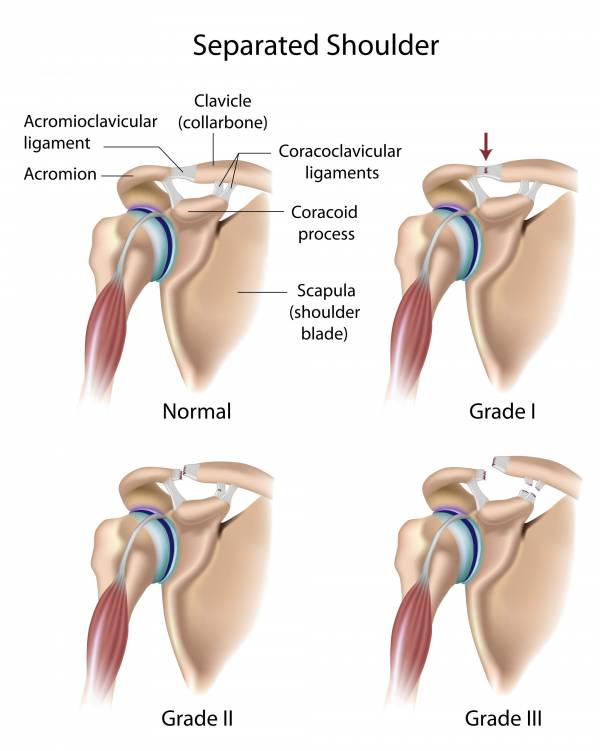A few weeks ago I wrote on the importance of addressing the upper back musculature to develop a stable and functional shoulder joint and shoulder girdle. Because of all the popular pushing exercises (i.e., bench press, military press, jerks, push presses), which primarily address the anterior (front) musculature of the torso, many neglect the posterior (back) muscles. These muscles are expressed primarily in pulling exercises (i.e., pulldowns, high rows, and low rows).
The balance of front and back shoulder strength is one thing, but attention must also be given to the other movements that occur at the shoulder joint and girdle. Neglecting a muscle group or movement can create potential issues over the long term.
As compared to another vulnerable joint – the knee – the shoulder joint/shoulder girdle is unique because of the wide range of articulations at the glenohumeral (ball and socket) and scapular-clavicular (shoulder blade and collar bone) areas. The knee involves mostly flexion (heel to the butt) and extension (straightening the leg). Pretty simple. The shoulder area is more complex and thus requires attention to properly strengthen and develop all the musculature surrounding it.
Let’s begin with the shoulder (glenohumeral) joint. These are the gross movements that occur there:
With the arm at your side:
- Raise it forward out in front (flexion), then back to your side (extension).
- Raise it laterally to the side (abduction), then down to the side (adduction).
- With the arm moved out in front (flexion):
- Move it backward parallel to the ground (horizontal extension).
- Move it forward from horizontal extension (horizontal flexion).
- Combine all of these movements by rotating the upper arm in a circular manner, clock-wise and counter clock-wise (circumduction).
With the arm held statically down at your side or abducted (raised laterally):
- Rotate the upper arm inward, turning the thumb to the front or downward (internal rotation).
- Rotate the upper arm outward, turning the thumb to the back or upward (external rotation).
Let’s now look at the shoulder girdle (scapula and clavicle). Movements there possess a shorter range of motion. Think “shrugs.”
With the arms down at your sides:
- Shrug your shoulders upward (elevation).
- Shrug your shoulders downward (depression).
- Shrug backward, pinching the shoulder blades together (retraction).
- Shrug forward, spreading the shoulder blades apart (protraction).
Because of the multitude of articulations at the shoulder, a greater risk of trauma exists. Don’t think so? Check out the list of shoulder joint/girdle potential malfunctions:
 Acromial-clavicular (AC) joint separation
Acromial-clavicular (AC) joint separation- Adhesive capsulitis (frozen shoulder)
- Arthritis
- Biceps tendon tear (where it originates at the shoulder)
- Bursitis
- Chronic shoulder instability
- Clavicle fracture
- Dislocated shoulder
- Labrum tear
- Rotator cuff strain
- Rotator cuff tear
- Scapula fracture
- Tendonitis
- Winged scapula
Gosh! A lot can go wrong here. So, what can you do to eliminate or at least minimize shoulder issues? The primary controllable precaution you can take is to implement a sensible shoulder joint/shoulder girdle strengthening program. Employ these movements and applicable exercises:
Glenohumeral joint:
- Flexion – front raise or front press.
- Extension – close grip pulldown, pull up or pullover.
- Abduction – side lateral raise or overhead press to the front (not behind the head).
- Adduction – wide grip pulldown or pull up to the front (not behind the head).
- Horizontal flexion – chest/bench press or chest fly.
- Horizontal extension – seated/bent-over row or rear delt fly.
- Internal rotation (upper arm down at the side or raised [abducted] to the side) – cable, band, or dumbbell internal rotation.
- External rotation (upper arm down at the side or raised [abducted] to the side – cable, band or dumbbell external rotation.
Scapular-clavicular joint:
- Elevation – dumbbell, barbell, or machine upward shrugs.
- Depression – dip bar downward shrugs.
- Retraction – seated or bent-over row shrugs (move the shoulders backward to pinch shoulder blades together).
- Protraction – chest or bench press shrugs (move the shoulders forward to increase the distance between the shoulder blades).
A program that incorporates the aforementioned movements and exercises should at the least minimize debilitating or nagging shoulder issues and allow you to train and compete consistently for a long time. Therefore, for a sturdy and functional shoulder joint/shoulder girdle, do this:
- Work all joint articulations – if it moves that way, strengthen it.
- If you do a pushing exercise, counter it with a pulling exercise.
- Always use proper exercise form – control the resistance.
And don’t neglect the smaller stabilizing shoulder muscles that make up the rotator cuff. Spend time fortifying them via internal and external rotation exercises with the upper arm at various positions.
Photos courtesy of Shutterstock.






